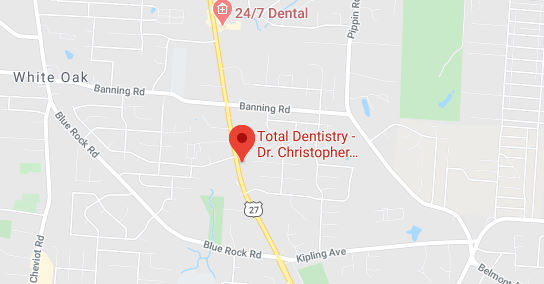Root Canals
Root Canals get a bad rap. So let us set the record straight.
Root canals don’t hurt. We’ve all heard horror stories of root canals taking many long visits to complete and of pain and agony accompanying each and every visit. This may have been the case 20, maybe even 15 years ago, but not today.
Technologies have improved, techniques have improved and more importantly, Dr. Omeltschenko actually perform lots of root canal procedures and is very experienced at them.
Here’s the real story on modern day root canals in our Cincinnati office:
What is a root canal?
A root canal can save a badly damaged tooth by removing disease from the tooth’s canals, filling the canals, and placing a crown on the tooth to strengthen it.
Why does my tooth hurt so bad?
Whenever a tooth begins to ache, it is usually a result of a chain reaction that occurs when bacteria invades the tooth. The most common way bacteria invades a tooth is through a crack or a deep cavity. The by-products of this invasion cause the nerves to swell and block the blood flow to the tooth, causing a toothache.
As a result of the block of the blood flow to the tooth, eventually the nerves of the tooth will die, thus killing the tooth. The process of the bacteria invading and killing the tooth can take several weeks. During this time, patients often experience cold sensitivity around the tooth and can even be wakened at night by the pain. To repair the tooth and alleviate the pain, a root canal is necessary.
Eventually, once the nerve and tooth are completely dead, patients will no longer experience pain. However, without root canal treatment, more serious problems can occur. Infection will set in because the tooth is filled with dead materials. Pus builds up at the root tip, in the jawbone, forming a “pus-pocket” called an abscess. An abscess can cause damage to the bone around the teeth. When the infected pulp is not removed, pain and swelling can result. Certain byproducts of the infection can injure your jawbone and without treatment, your tooth may have to be removed.
Why Shouldn’t I Just Have the Tooth Removed?
When a tooth is removed and you are left with an open space, many problems can occur, unless you replace the missing tooth. The space left by a missing tooth may cause some teeth to tilt forward, or opposing teeth to move down – which is called over-eruption. The tilting of teeth creates areas between the teeth where food debris and bacteria collect. These areas are especially difficult to clean so tooth decay and gum disease often develop in these areas. Also, a missing tooth can create spaces between teeth, changing your bite and smile. When your teeth start shifting and drifting due to open spaces, it can lead to changes in your chewing muscles, bones and joints, making chewing difficult or painful.
Missing teeth can be replaced with a bridge or implants, but these procedures are more costly than simply restoring the tooth’s health with a root canal.
Most routine root canals are completed in our office in one visit lasting about two hours. This includes having a crown placed on the tooth. Dr. Omeltschenko begins by getting your numb and then open the tooth and remove any filling or decay. The tooth will be cleaned out, so that the pulp, the inner “live” parts, of the tooth are removed.
Next, the canals of your teeth will be filled, an x-ray will be taken to insure all canals have been found and treated. After the inside of your tooth has been treated, the outside will be restored to protect your tooth’s underlying structures and give your tooth a healthy appearance. Dr. Omeltschenko will make a CEREC crown to restore the outside of the tooth. The crown is necessary to prevent fracture of the now weakened tooth.
Paying for my Root Canal Procedure
The cost of an root canal will vary, depending on the which tooth needs treatment. To see a list of the fees at our Cincinnati dental office, visit our Total Dentistry Price List page. Please keep in mind, most patients needing a root canal need two additional procedures to restore the tooth after the root canal: a buildup and a crown.
For patients with insurance, we will be happy to determine how much your plan will contribute towards a root canal, buildup and crown. We often see policies pay as much as 80% towards the price of a root canal and 50% towards the buildup and crown, after the deductible has been met.
For patients without insurance, we encourage you to join our Dental Savings Plan. This plan offers free exams and x-rays, as well as 10% off our other dental services, including root canals, buildups and crowns.
We believe that everyone deserves a beautiful smile…today! Patients can get started on treatment immediately by taking advantage of one of our monthly payment plans. Information on setting up a monthly payment plan can be found on our Paying for Treatment page.
If you are in Cincinnati and need a root canal, you will be in good hands at Total Dentistry. Don’t wait any longer to start your treatment, call us today at (513) 245-2200.

